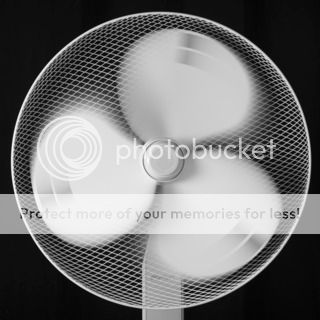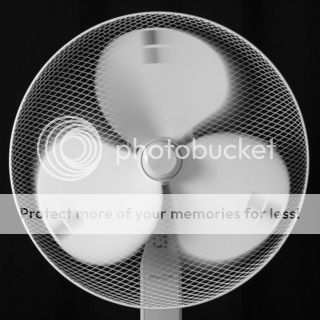- Messages
- 23,200
- Name
- Richard
- Edit My Images
- No
Appreciate your opinion on these pics if you would please - your estimate of the effective motion-freezing ability of the flash images in post number 2, compared to actual shutter speeds.
The first set of pictures below are for reference. It's a standard office fan with black and grey squares stuck on the blades. The images are taken with ambient/continuous light at actual shutter speeds to freeze the movement. Use these to compare against the flash pictures in the next post down, and give your estimate of what you think the movement freezing looks like in terms of shutter speed equivalents. Thanks.
It's harder than you might think. Flash durations can be difficult to measure, particularly with studio-type flash heads (voltage regulated). Unlike speedlight guns (IGBT regulated) where the flash pulse turns on and goes out very abruptly and is therefore easy to measure, the flash pulse of a studio head turns on quite quickly, but then fades away very gradually. The total burn time at different power settings doesn't change much, but the peak brightness changes a lot - that's what adjusts the exposure and it's basically the height of the peak that determines the movement freezing potential in visual terms. The industry uses a formula to calculate a 't.5 time'* that is supposed to represent the movement freezing ability, but it's well known to over-estimate by as much as three times the shutter speed equivalent. But what do you think? Can you put a number on it, using the actual shutter speed images for comparison?
Camera is Canon 5D2. There is some distortion of the fan blades due to the scanning action of the focal plane shutter, but it doesn't affect the blurring. The fan is spinning clockwise.
*t.5 is the time the flash pulse stays above 50% of peak brightness, as measured on an oscilloscope. There is another similar measure known as the 't.1 time' but very few manufacturers publish it.
Static

1/250sec
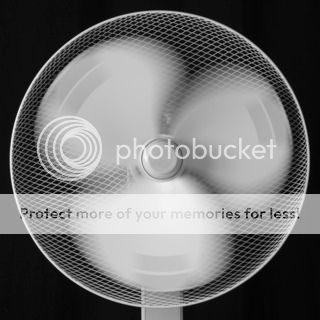
1/500sec
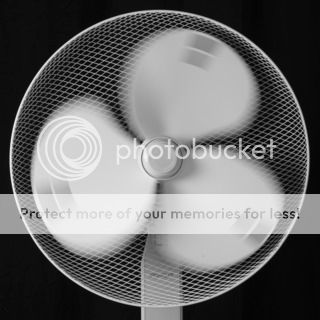
1/1000sec

1/2000sec
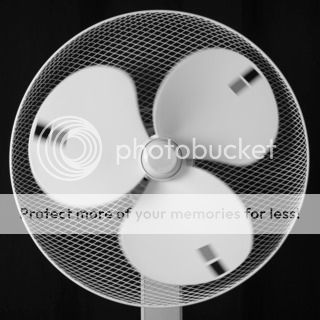
1/4000sec
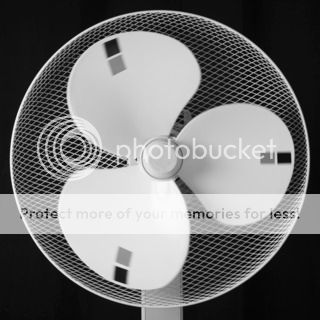
The first set of pictures below are for reference. It's a standard office fan with black and grey squares stuck on the blades. The images are taken with ambient/continuous light at actual shutter speeds to freeze the movement. Use these to compare against the flash pictures in the next post down, and give your estimate of what you think the movement freezing looks like in terms of shutter speed equivalents. Thanks.
It's harder than you might think. Flash durations can be difficult to measure, particularly with studio-type flash heads (voltage regulated). Unlike speedlight guns (IGBT regulated) where the flash pulse turns on and goes out very abruptly and is therefore easy to measure, the flash pulse of a studio head turns on quite quickly, but then fades away very gradually. The total burn time at different power settings doesn't change much, but the peak brightness changes a lot - that's what adjusts the exposure and it's basically the height of the peak that determines the movement freezing potential in visual terms. The industry uses a formula to calculate a 't.5 time'* that is supposed to represent the movement freezing ability, but it's well known to over-estimate by as much as three times the shutter speed equivalent. But what do you think? Can you put a number on it, using the actual shutter speed images for comparison?
Camera is Canon 5D2. There is some distortion of the fan blades due to the scanning action of the focal plane shutter, but it doesn't affect the blurring. The fan is spinning clockwise.
*t.5 is the time the flash pulse stays above 50% of peak brightness, as measured on an oscilloscope. There is another similar measure known as the 't.1 time' but very few manufacturers publish it.
Static

1/250sec

1/500sec

1/1000sec

1/2000sec

1/4000sec

Last edited:



